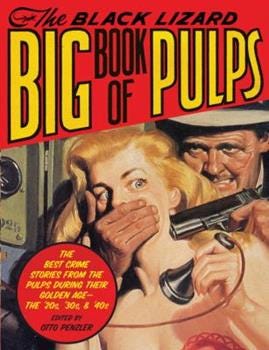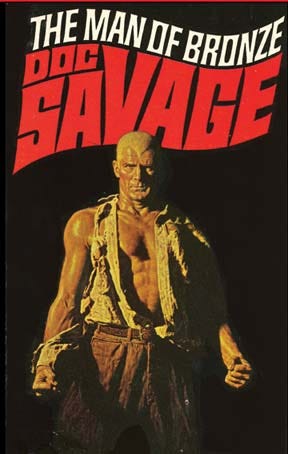The House That Pulp Built
Part One of an ongoing series that looks at the lost tradition and lasting influence of Pulp magazines.

One of my favorite pastimes as a child was going to my local library. For me, it was no better place to be. I would occupy one of the private rooms inside and scribble away in my notebook after combing through shelves of books. I don’t do it as often as I’d like anymore, but when the moment presents itself, I try to take full advantage.
My most recent trip turned out to be a memorable one. While my only intention was to return some books and DVDs my wife had borrowed, I ended up spending a good 2 hours inside. But this time was different.
Scanning the shelves of fiction I found myself in the mystery section. I found maybe two books out of hundreds that piqued my interest: Dead Girl Blues by Lawrence Block and a collection of Ellery Queen short fiction. I threw them both back on the shelves when my eyes met this incredible door stopper with a painted cover from what looked like the 1940s and big yellow text that screamed: Big Book of Pulps, a curated collection of the best crime stories from the golden age of pulp fiction from the 1920s to 1940s!
Wow!
I snatched it up and rushed to the front desk to check it out almost immediately. I raced home thinking I struck gold and couldn’t wait to dive into the seedy underbelly of hardboiled detective fiction.
This collection had it all. Raymond Chandler, Cornell Woolrich, Frank Gruber, Earl Stanley Gardner, James M. Cain, Dashiell Hammett, and more. Not to mention two great introductions from two great Harlans: Harlan Corben and Harlan Ellison. This was all put together by Otto Penzler, an editor of mystery fiction and proprietor of The Mysterious Bookshop in New York City.
Reading these stories was an out of body experience for me. Not just because it’s a great collection of work, but because this impromptu trip to the library cemented my deep love, appreciation, and fascination with an American tradition that has been almost forgotten.
Pulp Fiction.
The ones who stumble upon this post and read those two words may very well think of the Tarantino flick of the same name from the ‘90s. But…those two little words lead to a rabbit hole of great literature (yeah I said it! Literature, dammit!) from a time long since gone but so influential it cemented its core elements into the modern day culture of entertainment. Everything from film genres such as Gangster flicks, Noir, and Westerns, to the golden age and silver age of comic books and the current Marvel Cinematic Universe began with the inception of the Pulps.
Before The Man Of Steel, There Was The Man Of Bronze
Starting with the dime novels from the late 1880s, the pulps created a marketplace of fast paced, action filled stories of adventure, space opera, jungle men, spies, detectives, cowboys, and supermen. Heroes littered the pages of cheap wood pulp books that were purchased from the spinning racks of the newsstands, drug stores, and train stations alike for a few hours of easy entertainment. One of those heroes was Doc Savage, known as the Man of Bronze.
The character of Doc Savage was created by real life adventurer Lester Dent who wrote over 150 Savage novels under the name Kenneth Robenson. After learning that a co-worker earned a good chunk of cash for submitting a story to a pulp magazine, Dent ventured onto his own path into the pulps and built himself a fortune. He earned a contract from Dell Publishing for $500 a month in 1931 during the Great Depression.
Don’t worry, I looked it up. That $500 a month contract in ‘31 would be worth almost $9,000 in 2022! Why make $40 a month working for the WPA when you can punch keys on a typewriter for $500 a month?
Much of what made Doc Savage a legendary character to readers of the pulps trickled into superhero comic books only a few years later. Clark “Doc” Savage, influenced Clark Kent. Both men occupied a fortress of solitude and were known to be the strongest men alive. This hardly scratches the surface for not just the similarities with Superman and Savage, but also other pulp characters like Zorro and The Shadow influencing characters like Batman.
From Flash Gordon to Luke Skywalker. Black Bat to Daredevil. It won’t take long for anyone to uncover that the richness that inspired the most iconic characters in comic books began with the pulps.
These books instilled a great tradition that seems to be lost on modern writers - telling damn good stories. The Conan stories by Robert E. Howard may not have been on my summer reading list in school, but I’m pretty certain if a teacher had placed these epic tales of sword and sorcery instead of the English class standard The Pearl I probably would have looked forward to reading more in my youth. There’s nothing wrong with Steinbeck but if my 14 year old self had to choose between a short parable of a rancher’s quest for riches with a depressing ending or a hero who embarks on various adventures of fighting monsters and saving princesses, my teenage brain would have gone with the latter.
The debate between what was regarded as “true” literature and hack work continues to this day. For what it’s worth, I think one should read simply for the pleasure of reading. If you take pleasure in reading the tome of Ulysses, that’s fine. If you enjoy the westerns of Louis L’Amour, then by all means enjoy them. If you just love a damn good story, find yourself lost in its prose or plot, and don’t care what category it falls into, then my God get to it. Read whatever fascinates you and read it well.
Punching The Keys
The pulp writers of yesteryear were able to capture the minds and the imaginations of the audience they wrote for. Typical readers of pulp included the working man, the laborer, the commuter, the housewife, the rambunctious teen, whatever. There was a pulp magazine to satisfy the taste of anyone. Pulp writers such as Lester Dent, Frank Gruber, Johnston McCulley, and H. Bedford-Jones wrote fast and they wrote clean. Writing at a penny-a-word was nothing to sneeze at in those days, especially during the economic hardship of the times. It was straight-forward, black and white. Either you bang out a well crafted story for the magazines or you didn’t get paid. No writer’s block. No bullshit. If you wanted to be a working “puplster” you were busy punching the keys.
Where Are We Now?
The craze for the pulps came to an end during the 1950s when television took over the world as the ruling medium. And even though the TV set was the final nail in the coffin, the legacy that pulp fiction left behind cannot be ignored. The Shadow, Conan, The Phantom and many more made it to the big screen. Some of these adaptations hit the box office to disappointing numbers but built lasting cult followings. Many of these books continued to leave their mark in the style of film serials which would later influence filmmakers like George Lucas and Steve Spielberg to create blockbusters such as Star Wars in ‘77 and the Indiana Jones franchise in the 80s.
Harlan Ellison referred to comic books as America's literature and I think the same must be said for the pulps without question. While the golden age is over, there are pockets of pulp fans all over the world who are keeping the tradition alive today both online and in person.
Most are avid collectors of the sensational cover art or readers of the books. Others are practitioners of the craft, spurring up a new wave of “pulp fictioneers” in the age of Amazon Kindle Direct Publishing, which is bringing about a kind of renaissance.
I’ve spent the last two weeks curating a humble start to a collection I hope to grow of westerns, adventure, and crime fiction. Lord knows how much money I’ve spent on books on the history of these books and their writers. All in the name of research of course!
If I’ve piqued your interest in America’s forgotten literature, wonderful! Since there is too much information to list in just one essay, please consider this “Part One” of what may be a long series on the history of pulp fiction. I’ll be branching out into many different areas such as genres, writers, and covers just to name a few.
I’ve even decided to make an attempt at crafting my own pulp inspired stories and will be publishing them soon. Should be fun!
Tune in next time.




